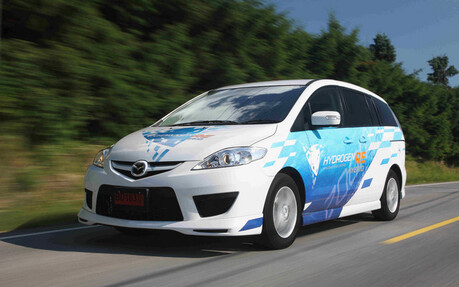Hydrogen part of Mazda’s future
Mazda’s got a plan for reducing its fleet’s overall consumption by 30% by 2016. The plan includes making several improvements to their conventional models equipped with internal combustion engines that run on gas. But in addition to that, the Hiroshima-based company is looking to include hydrogen as a simple, cheap and practical solution over the short and medium terms.
And, they’ve got an Ace up their sleeve: the Renesis rotary engine which runs very well on hydrogen even while it continues to use conventional gasoline when you run out of hydrogen. This engine is allowing Japanese engineers to create a unique powertrain that is flexible, has lower CO2 emissions and results in very impressive fuel consumption rates. And should gasoline ever become scarce, the vehicle could run on hydrogen alone.
Why a rotary engine?
Mazda is the only automobile manufacturer to sell cars with rotary engines. When using conventional fuel, this kind of engine can put out increased power in proportion to its displacement. The current RX-8’s engine can pump out 233 hp from 1.6 litres of displacement. And given its super-compact dimensions, this engine is easier to fit in the vehicle. The weak points are higher than average fuel consumption and occasional lubrification troubles. But Mazda continues to refine and develop this engine, and one of the reasons for this is that it works very well with hydrogen. How? Hydrogen has a much higher burn rate than gasoline, which makes it tricky to use in a conventional engine. In rotary engines, however, the temperature in the combustion chamber is lower than in a conventional engine, which optimizes output. This means that a clean-burning fuel can be used, because the only by-product of burning hydrogen is water vapor. What’s more, these engines are relatively easy and cheap to make.
A very special Mazda5
Mazda engineers have made good use of these characteristics to develop a hybrid engine that is quite unique. In short, it uses some of the technology found in the Chevrolet Volt, but without the plug-in rechargeable batteries. They used a Renesis rotary engine and paired it with an engine-powered generator. This generator charges ion-lithium batteries which feed the electric engine on the front powered axle. And if the hydrogen runs out, you can always switch to regular gasoline, as you could with the Volt. In the Volt, however, you could go a lot farther on the batteries alone. But the Mazda does offer the advantage of almost always using hydrogen as its fuel source, meaning that regular gas is really only needed as a temporary solution to get you to the next hydrogen station.
We had the chance to test drive a Premacy (which is what the Mazda5 is called on the Japanese market) equipped with this kind of power train, and I must say that this prototype impressed us with its potential more than its actual performance. The test drive was relatively short and the engine performed extremely well. In fact, our main complaint was the rather loud sound of the engine. That said, the braking energy recuperating system was effective and transparent, while accelerations and upshifts were also pretty good. Looks like this technology will be a great alternative once it’s been developed a little more. During the same presentation, Mazda let us take out an RX-8 that ran on hydrogen. Once again, this vehicle can switch from hydrogen to regular gas with the touch of a button. The test drive led us to conclude that this technology should be viable over the long term thanks to the ecological qualities of the power train. As far as the rest goes, it drives more or less like a conventional RX-8.
Other solutions
Both the Premacy and RX-8 RE are long-term solutions. But over the next few years, Mazda plans on adopting several other solutions to reduce their fuel consumption by 30%. What this means is that we’ll see their new engines use more modern technologies, such as direct fuel injection, infinitely variable valve timing, and more efficient cylinder head design. Mazda also plans to make their vehicles lighter by adopting new methods of assembly that require less material, new frame and platform structures, and lighter materials.
Among the other solutions that Mazda engineers are considering is a new direct transmission that’s more effective and efficient thanks to reduced internal friction. They’re also developing new diesel engines that consume about 30% less than gasoline engines with the same cubic inch displacement. However, Mazda does not plan on importing vehicles with diesel engines until they’ve developed an effective automatic transmission to go in them and they can be sure that the direct transmission currently being developed will do the job right.
Finally, the I-Stop technology that allows the engine to stop when the vehicle is not in motion and start again almost instantly when you step on the accelerator is already offered in Japan on all models with 2.0-litre engines. This reduces fuel consumption by about 10% when driving in the city. However, the North American norms for urban driving will not permit such good results, which means the introduction of I-Stop will be delayed on our continent.
Overall, it looks as though Mazda will be able to reach its objective and reduce consumption by 2016, even with their conventional-engine vehicles. But their hydrogen power train technology looks both innovative and promising.
